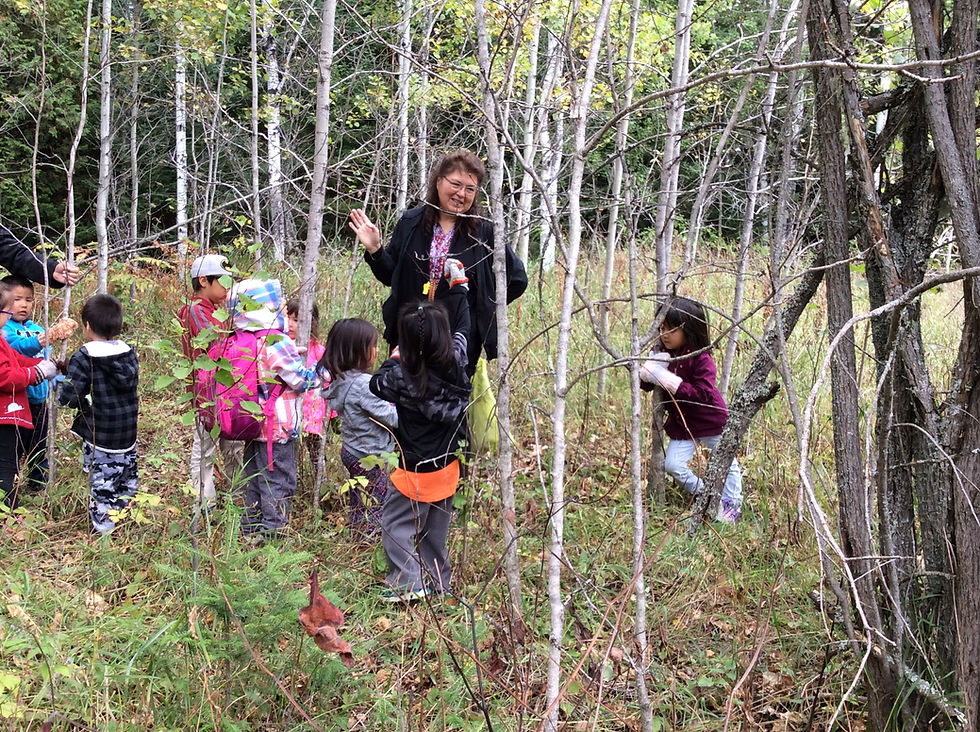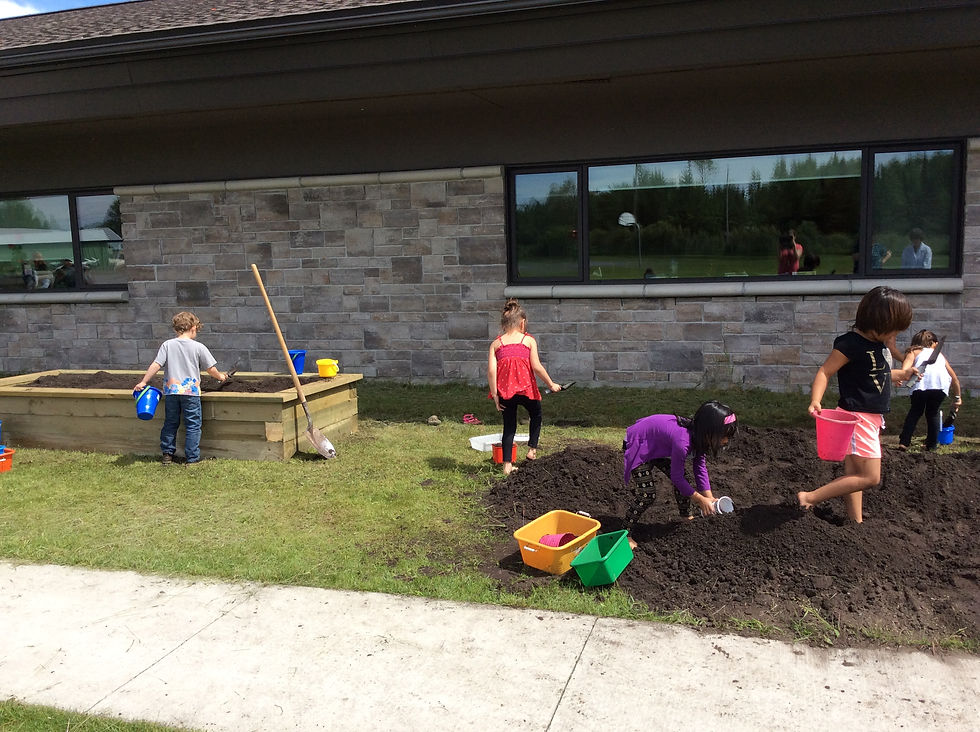Marge & Sara's Story
- naturalcuriosityed

- Mar 10, 2021
- 7 min read
Updated: Nov 29, 2021
Honourable Mention for Natural Curiosity's National Edward Burtynsky Award for Teaching Excellence in Environmental Education

Marge and Sara are the Kindergarten team at Mine Centre School and work side by side each day engaging students in inquiry-based learning. Marge is an elementary teacher and Sara is an ECE.
Marge and Sara are leaders in environmental inquiry in our school board. Together they began taking our students out to an outdoor learning area close to our school that has become known as ‘camp’. Each Tuesday for 100 minutes (and often more!) the kindergarten class ventures out to camp to learn on the land. Rain, snow, and cold weather do not hinder their visits.

Marge and Sara have brought in guests, knowledge holders and Elders to learn about plants (including traditional uses of plants), animals and tracks, flowers, mushrooms, and more. One year, they built pine marten boxes and put these boxes up in the camp area to attract pine marten. The class did an inquiry on rabbits, stemming from the sighting of a rabbit that had changed colour in the fall. Students conducted experiments to find out what rabbits eat, measured rabbit hops, wrote about rabbits, and read about rabbits. They were able to set up trail cameras and take pictures of the rabbits at their ‘feeding stations’.
96% of the students in our school are self-identified as First Nation students. The work that Marge and Sara do with the students out at camp honours the Indigenous perspectives these children have and builds on their cultural knowledge and understanding.

Outdoor Education at Mine Centre School
At Mine Centre School we are very fortunate to have the forest in our backyard. In the kindergarten classroom we take full advantage of our surroundings and spend ninety minutes once or twice a week immersed in nature. Four years ago the kindergarten team worked with community members to map out and trim two trails and make a lean-to and a fire pit. Next, the kindergarten students joined the adults in clearing away brush to make the space their own. Initially the students were very cautious to explore beyond the main meeting place unless they had an adult with them, but as they became more familiar with the area and more comfortable with their ‘bush legs,’ they started going off in small groups, and eventually exploring independently. The students are reminded to follow the ribboned trail, and know that when the whistle blows they all have to return to the main site. Over the next few years there were two more trails built, one which travelled up a big rock that the children called ‘the mountain’, and another which wound its way through the forest with many fallen trees to climb over. Each time we meet at camp we make a plan and then children head off in small groups to accomplish their tasks before having the chance to explore on their own.

Our approach to environmental learning is to get our students out on the land and immersed in nature. We want students to be comfortable in the outdoors, to love being outside and to feel safe outside. In order to do this, we go to our camp as often as we can. Though we are careful not to take too much, we also bring nature into our classroom, with collections of treasures such as pine cones, acorns, rocks, feathers, seeds, moss, nests, and branches chewed by rabbits.
We try to keep a balance of teacher-led and student-led activities. We listen carefully and watch for what interests the students and what they are talking about with their friends. On one occasion, students saw a white rabbit in late November. This sighting led us into an inquiry about why the rabbit was white when there was no snow on the ground. Through research, we learned that the length of daylight causes changes in the pigment of the rabbit fur. On another occasion, we set up a simple experiment to see which food the winter birds would prefer to eat. Would it be popcorn, bird seed or peanuts? From our trail camera we observed the first choice was bird seed, then peanuts, and lastly popcorn.

When we begin going to camp at the start of the school year, we offer tobacco and gather cedar to hang in the classroom. Many of our conversations focus on respect and care for the land and animals, and throughout the year we work our way through the Seven Sacred Teachings: Love, Respect, Courage, Honesty, Wisdom, Humility, Truth. We often start off the year by inviting a local elder to talk about trees. The students learn about which trees can be used as medicine and choose a specific tree to get to know. Students learn the tree’s name, measure its circumference, taste its sap, feel its bark texture, and note if there are needles or leaves. Throughout the school year they visit their tree often to see how it is doing.
We make an effort to reach out to the local community to support the experiences we have in the classroom and at camp. One year, we learned basic information about pine martens, including their habitat, food, predators and offspring. Then we constructed pine marten boxes with the help of a local trapper and mounted them on trees near our camp and observed to see if pine marten would occupy them. The local trapper showed us pelts and answered our questions about pine marten. He also talked about the importance of helping increase the population of pine marten in the area.

Each year students pick a special spot at camp. They take a photo of their spot and explain why it is so special. Several times throughout the year, students draw a map of camp or a map of how to get to camp. Over time their map drawing improves with detail and accuracy. We help our students make connections with a wider community during our Connected North virtual learning sessions. Students learn that information can be gathered from individuals that are far away. They have been able to learn about different animals, talk with scientists and experts about mushrooms and fungus, visit a market garden, learn about pollinators, and talk to authors.

When we observe seasonal changes, we notice the plants, animals, trees, changing landscape, changing weather and how people’s activities change too. From the first snowfall in November to the last snowfall in April we tracked the depth of the snow. We used a measuring stick and recorded the information in a graph so that students could see changes over a period of time. In the spring, we learned about plant cycles from a local gardener and watched the growth process of our classroom vegetable garden. In the following fall, we harvested our vegetables to eat. We also saved and dried some of the seeds for our next year’s planting. We have participated in harvest activities, with individuals from local communities passing on traditional knowledge. Students have prepared wild rice, plucked the feathers off ducks and seared the pin feathers off over an open fire, identified different kinds of fish and ate them.

Our program lends itself to cross-curricular learning. When studying geometry, we go on shape walks and identify items along the trails that look like shapes we are learning about: for example, a stump is a cylinder, a rabbit dropping is a sphere, and many evergreen trees are cones. We have used plants from the camp as food and medicine. We have cooked with high bush cranberries and made a soothing tea from spearmint leaves and cedar. We have taken the class on field trips to the farm to learn how land is used in a different way and to see animals that provide food. We have also taken students to a bog and walked along the boardwalk to learn about a different environment.
Camp has become a truly special place that can refresh the body and calm the mind. It is a place where students develop emotional ties and share their feelings with friends and family. We emphasize respect for people, animals and plants at camp and in the classroom. We give students the message that nature may need their help to stay healthy. From insects to larger animals, each should be free to live where they are. We provide containers for students to closely observe insects that they might otherwise step on. We release them at the end of the day in hopes of meeting them again. We bring along a ‘Look and See’ backpack to camp that contains magnifiers and binoculars. Students use these tools to observe the small creatures and things that are far away. If you can look closely at something, there is a better chance you will appreciate it.
When we leave our outdoor classroom we are sure to be respectful to the land. Tables are put under the shelter, toys and garbage are taken back to the school. We are modelling respect for the area. We recently had the students help make a new lean-to for our camp. This meant cutting down trees and removing the branches. We talked about how sometimes we need to use things from nature. We placed down tobacco to show respect to the Creator before removing the trees. We covered the lean-to with a recycled tarp from a portable outdoor carport. We encourage students not to pick plants or flowers, break tree branches, or harm small insects. We want them to learn that you can’t always just take, and that we should keep things in nature so we can enjoy them next time.
We feel that if you are going to learn about nature, you need to be out in nature. When you spend a lot of time in the bush learning and playing, the bush becomes a kind of home. You care about the land. Students become intimately connected with this special place and memories linger far beyond their experiences in this grade.














Comments